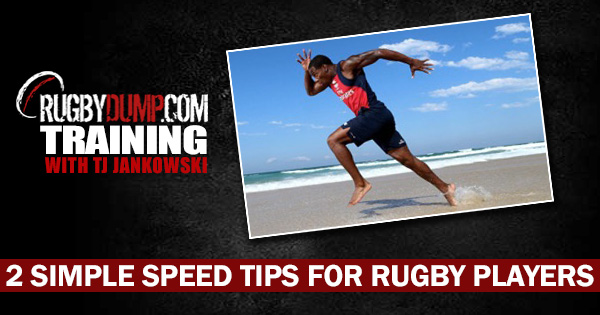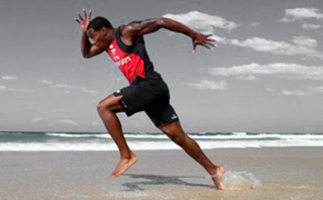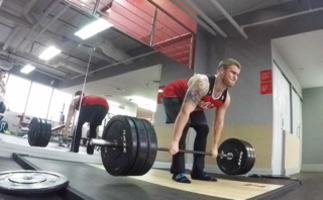
Today’s training post from Rugbydump Academy S&C coach TJ Jankowski explores the myth that if you’re not born fast, you never will be. TJ provides us with two simple steps that if done correctly, should make a noticeable difference to your outright speed.
When talking about speed it is common for people to think (and say), “You’ve either got it or you haven’t”. Let me just say right now, that simply is WRONG.
Everyone has the ability to get faster, and if you want to become a better rugby player, moving at a greater speed is probably going to make more difference than improving any other quality.
Speed kills! Do not think that getting faster is only a benefit to those wingers or those that play 7s. Whether you’re chasing down the opposition, running a support line or making a break yourself, players from every position can hugely benefit from getting their wheels upgraded!
Whether you’re reading this thinking “I’m already fast, I don’t need to do much improvement” or “I’m destined to be slow”, you’re wrong.
Paul Jordaan gas
Getting fast is as simple as putting one leg in front of the other, literally. So today we’re going to talk the 2 basics of improving your speed.
1. Practice Sprinting
It amazes me how seldom rugby players practice sprinting. Now don’t get me wrong here, I do see many guys doing sprints, but they aren’t practicing sprinting to get faster and improve their speed.
Most guys run sprints to get a burn on their lungs to get ‘fitter’.
Not only is this not making them faster, but sometimes it can make them slower!
“OMG, how?” scream the high-school girls reading this.
Bad habits – when you are fatigued your sprinting form will drop, (when your form drops, you get slower) and if you are constantly sprinting with crap form then you’ll get used to it, and that will be your form when you’re fresh. Not good.
I’m not saying to completely ditch getting fitter, obviously it’s needed, but it needs to be supplemented with some speed work.
Note: This speed work is still going to help your fitness in it’s own way. Think about it, if you get faster then the same coasting speed will be a lower percentage of your all-out speed and therefore easier.
So what would a sprint session look like?
For rugby the most important aspect we need to focus on is your short-speed/acceleration.
Everything in rugby is done in a pretty small space – if it takes you 30m to get to your top speed, you probably aren’t going to be getting to top speed often in a game and working on 100m sprints isn’t going to be much use to you.
So, unless your focus is 7s then there’s not much need to sprint more than 40m.
The next important aspect of the session is your recovery. Remember that you’re practice sprinting, this means that the emphasis must be on the sprinting itself.
That means recovery must be as close to 100% as you can for each rep – if you’re not fresh for each rep, your sprinting will suffer.
You should not be exhausted or feeling fatigued during the session. In fact when finishing a good sprinting session, you will feel fresher and more energised than when you started.
To ensure this, a good sprinting session should last around 45 minutes at most.
Here is an example of a simple session:
– Warm Up
– 10 x 15m sprints (walk back slowly and recover as needed)
– 8 x 25m sprints (walk back slowly and recover as needed)
– 6 x 40m sprints (walk back and recover as needed)
– Cool Down.
Now whilst I don’t want to get too much into sprinting technique – we want to keep things simple – I will say that you must make sure you drive from your toes, only letting your heels touch the ground when you make a side-step.
We should also learn from the body angle of the fastest rugby player on the planet.

These sessions are so simple and will give you so many benefits on the pitch, you’d be silly not to do them.
2. Get Stronger
When you’re sprinting, you’re pushing yourself off the ground and propelling yourself up and forward. The more force you can apply to the ground, the more powerful your will foot will launch away from it, and thus the faster you will run (this is a simplified version of how it works).
For some reason people say that strength training makes you slower, well these people are idiots. Yes, if you do nothing but strength, never practice sprinting, eat donuts and get fat, then you’re probably going to slow down. But if you can get stronger and still apply that strength to your sprintingm then you’re winning.

Now we could look at jumps, and a whole host of explosive exercises with barbells, kettlebells dumbbells and bands, but this article is ‘SIMPLE speed tips’, so we’re going to take one exercise and make sure you’re doing it: deadlifts.
These specifically can really develop the posterior chain (sprinting muscles) more than any other movement.
When you’re deadlifting, you’re not really picking the weight up as much as you are applying as much force to the ground as needed in order to straighten your legs and bring that weight with you…. Does that ‘force to the ground’ bit sound familiar?? It should.
Now we could (and will next week on Rugbydump Academy) go into a full hours workshop on deadlift technique and variations for different body types. You just need to remember that when you are deadlifting, you start with a neutral spine and use the legs rather than the lower back.
And by legs, I mean you need to drive from the hips – it’s a hinge rather than a squat.

Keep in mind that whilst you should be pushing yourself, the end goal isn’t the barbell – it’s the rugby pitch, so don’t feel the need to go beyond what you can handle with good technique.
So there you have it. You can fanny around running up or downhill, use bands and do fancy footwork drills. Or you can do these two simple things and get faster than ever before. In double-quick time.
About TJ JankowskiTJ Jankowski is a former international rugby player for Poland rugby, who achieved their highest world ranking of 23 whilst he was part of the team. It was this reward from hard work that led him to become a coach and help other achieve greater success than he could. TJ now works as an expert Personal Trainer in the middle east, coaching heavy lifting and personalised nutrition to help a wide scope of clients achieve their goals in a sustainable manner. A competitive weightlifter himself, he also has a keen eye to help others perfect their technique, particularly in the olympic lifts. Having said all that, he prides himself on creating programmes and nutrition that work in the real world, not with robots. TJ has worked with international rugby players from 4 different continents and we are thrilled to announce that he can help you as part of the Rugbydump Academy |
|

Sign In